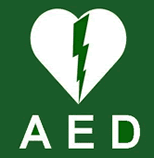AED: a must-have or not in your company?
Research conducted by Mensura occupational physician Mouloud Kalaai has shown that the automatic external defibrillator (AED) is increasingly popular. But what does an AED do exactly? Is the portable device safe to help save lives in the workplace? And which legal obligations should companies comply with if they have an AED?
Restoring the cardiac rhythm
Every day in Belgium, thirty people suffer a cardiac arrest. So, the bigger your company, the greater the chance that this will happen to one of your employees. The risk is higher for:
- employees who perform heavy physical work;
- in companies where there is an electrocution hazard;
- or where extreme temperatures are measured.
Ventricular fibrillation is actually occurring in one in two cardiac arrests. When this happens, the ventricles vibrate in a chaotic pattern and the heart can no longer pump blood. The body is then deprived of oxygen. Irreparable brain damage can occur already three minutes into cardiac arrest. For every minute the heart stops pumping, there is about 10% of heart tissue loss.
On average, it takes seven minutes for an ambulance to arrive at the scene. Consequently, resolute and knowledgeable action is literally of vital importance.
Guaranteed safe
Ventricular fibrillation is exactly what an AED can remedy. The portable device analyses the heart rate and automatically determines whether an electric shock is needed. The device guides the rescuer with voice instructions until medical help arrives at the scene.
A specific training course perfectly prepares first-aid workers in your company for such situations. Among other things, they learn to perform CPR immediately, make sure that the AED is in the right place and use the device properly. That’s crucial, since timely defibrillation can triple the chances of survival. Searching for an AED for ten minutes without starting CPR is tantamount to a death sentence for the victim.
Statutory obligations
You must clearly indicate the place where you are providing an AED with this statutory symbol:

- Register your AED at the FPS Public Health using the official online form. Stick the registration number that you receive on the sealed cabinet and the device itself.
- Keep the FPS Public Health info sheet about resuscitation in the AED cabinet.
- Affix the following text on the cabinet:
Only to be used if the person is unconscious and does not display normal breathing. Always notify the emergency medical assistance centre by dialling 100 or 112 if the AED is used.
- As the owner, you must check the device after each use and monthly. Are the alarm messages still working? Have the batteries been recharged? Is there an intact pair of electrodes? Record all checks in a registry.
- Register each use of your AED and submit this data to the Directorate General for Basic Health and Crisis Management, and, upon request, to the attending physician.
You will find the complete overview of legal requirements here.
By following our basic “CPR and AED use” course, you and your employees will act swiftly and effectively in the event of a cardiac arrest. For more advice on CPR and an AED in your company, feel free to contact us at health@mensura.be.